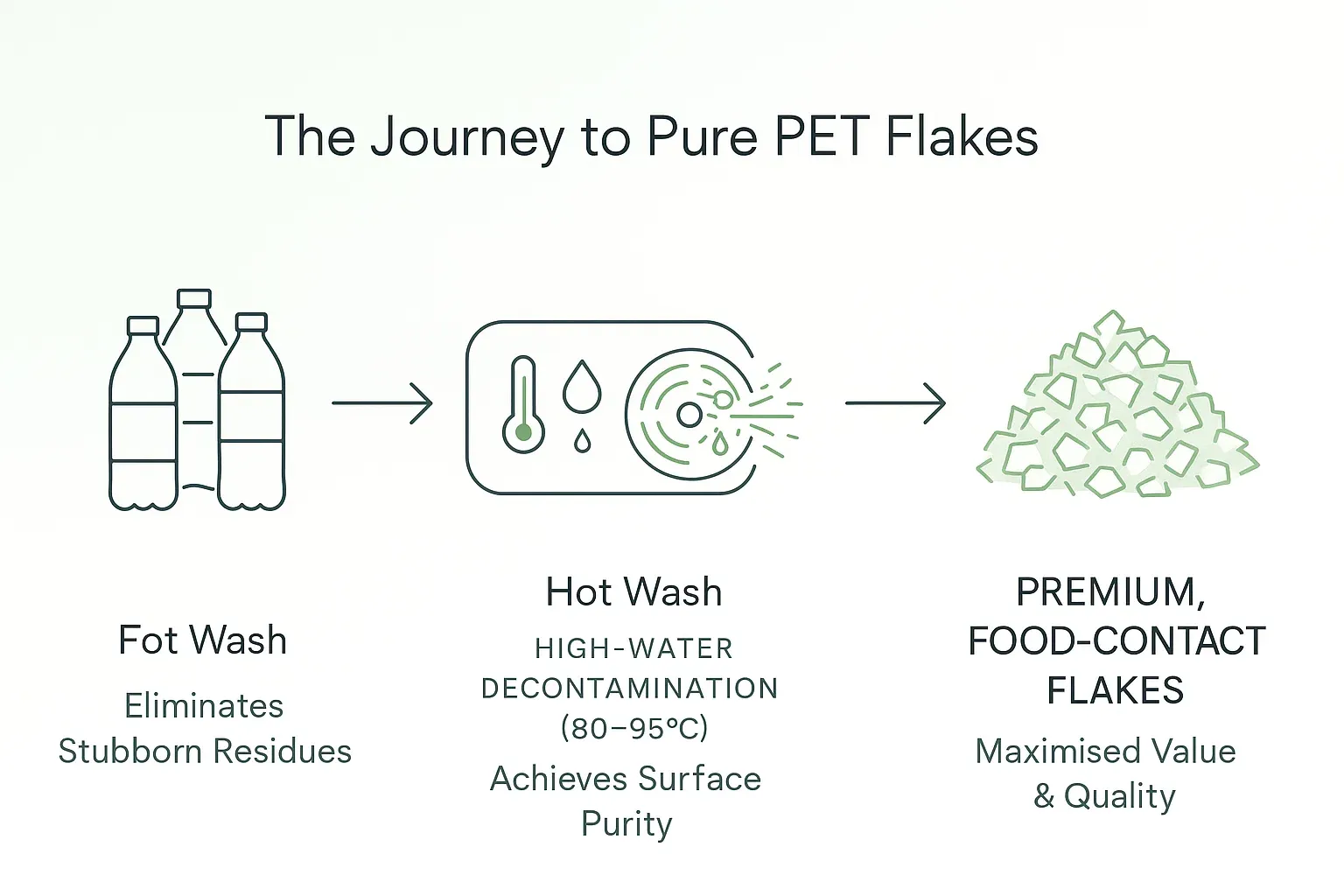Why Thorough Washing is the Cornerstone of Every PET Recycling Line
The purity of PET flakes is paramount, directly influencing downstream pellet quality, operational uptime, and the ultimate value of your final product. Lingering residues from labels, glues, and sugars can lead to undesirable yellowing, the formation of acetaldehyde, and increased Intrinsic Viscosity (IV) loss. These are critical issues that translate directly into higher scrap rates and potential customer dissatisfaction. By upgrading to a state-of-the-art hot-wash and friction-wash combination, facilities typically elevate their end-flake quality from ‘textile-grade’ to food-contact-ready. This enhancement can boost the output value by a significant 20–30% per tonne. ([Energycle][1], [retechmachine.com][2])
Delving into Hot Water Washing Technology
How It Works
This advanced process utilises a jacketed, stainless-steel reactor – commonly referred to as a ‘hot wash pot’. Within this vessel, PET flakes are circulated in water heated to 80–95°C, treated with an alkaline detergent. Specially designed agitators maintain the flakes in constant suspension, while efficient steam or electric heaters ensure the water temperature is consistently sustained. The flakes typically reside in the reactor for 15–20 minutes, after which they are discharged to a high-speed dewatering centrifuge to remove excess water.
Key Advantages
| Benefit | Why It Matters | Engineering Note |
|---|---|---|
| Unmatched Decontamination | Effectively dissolves stubborn glues, shrink-sleeve inks, and sugar syrups, achieving label removal rates of 99% or higher. ([nicetymachine.com][3], [Plastic recycling machine plant][4]) | Crucial Engineering Detail: Maintain caustic concentration at 1–2% and monitor temperature continuously using inline sensors for optimal performance. |
| Achieving Food-Grade Sterilisation | The high operational temperatures effectively eliminate microbial loads, ensuring compliance with stringent FDA/EFSA bacterial plate-count limits for food-contact materials. | Material Recommendation: Employ 304L or 316L grade stainless steel for reactor construction to withstand demanding caustic and heat cycles. |
| Enhanced Flake Value | In the EU market, hot-washed flakes typically command a premium of €60–€80 per tonne, reflecting their superior quality. ([Energycle][1]) | Energy Efficiency Tip: Integrating heat-recovery exchangers can reduce energy consumption by as much as 30%. |
| Reduced Downstream Chemical Costs | Producing cleaner flakes significantly lessens the need for anti-dusting agents and IV-restoration additives further down the line, leading to cost savings. | Process Optimisation: Incorporate a closed-loop filtrate reclaim system to minimise water wastage and chemical loss. |
Unpacking High-Speed Friction Washing Technology
How It Works
Contained within a robust horizontal or vertical housing, a high-speed rotor, spinning at 800–1,200 rpm, propels PET flakes against a specially designed perforated screen. This action generates powerful shear forces that meticulously scour off organic contaminants. Simultaneously, precisely aimed nozzles inject a fine water mist, which aids in flushing these impurities through the screen openings.
Key Advantages
- Thorough Surface Scrubbing: Effectively eliminates embedded contaminants such as sand, paper fibres, and loosened adhesives that might have bypassed earlier pre-wash stages. ([Energycle][5], [amgplastech.com][6])
- Exceptional Water & Energy Efficiency: Advanced designs boast minimal water consumption, using as little as 0.5 m³ per hour, thanks to innovative atomised spray technology and partial water recirculation systems. ([Energycle][5], [lianshunmachinecn.com][7])
- Integrated Dewatering: The inherent centrifugal force efficiently expels approximately 25% of free water from the flakes, significantly reducing the load on subsequent thermal dryers and saving energy.
- Durability and Low Maintenance: Engineered for longevity with exchangeable screen segments and hard-faced paddles, these machines offer over 8,000 operating hours between major overhauls, minimising downtime.
The Synergistic Power of Combined Washing Stages
An industry-proven, highly effective sequence integrates these technologies as follows:
- Bale breaker & wet granulator
- Pre-wash trommel
- Hot water washer
- Rinse centrifuge
- غسالة الاحتكاك
- Final float-sink, rinses & thermal drying
This strategic dual-stage configuration maximises yield by minimising the loss of PET as fines. Crucially, it consistently achieves glue content levels below 50 ppm, meeting the stringent protocols required for bottle-to-bottle recycling certification. To visualise a comprehensive turnkey solution, we invite you to explore this detailed PET bottle recycling and washing system layout.
Maximising Returns & Operational Excellence
- Swift CAPEX Payback: Expect a return on your capital expenditure within 18–30 months when upgrading from a cold-wash-only system. This is based on a typical 3 tonnes per hour (t/h) line and achieving an average €70 per tonne premium for high-quality flakes.
- Optimised Heat Recovery: Implementing plate heat exchangers can recover up to 80% of the sensible heat from spent wash liquor. This significantly reduces boiler duty and energy costs.
- Sustainable Water Management: Advanced ultra-filtration (UF) combined with Dissolved Air Flotation (DAF) systems can dramatically reduce fresh make-up water requirements to less than 1% of the total process flow, promoting sustainability.
- Proactive Predictive Maintenance: Integrating vibration sensors on the friction washer rotor allows for early detection of imbalances. This foresight helps prevent costly catastrophic bearing failures and unplanned downtime.
Choosing Your Ideal Pet Bottle Recycling Machine
- Analyse Your Feedstock’s Contamination Profile: The nature of your input material is key. For example, PET from markets with high volumes of sugary soft drinks will derive maximum benefit from a hot wash system. Conversely, bottles previously containing agricultural chemicals might necessitate an upstream caustic soak for effective decontamination.
- Balance Line Capacity with Available Footprint: Consider your production targets alongside your site’s physical constraints. A compact, vertical friction washer can be an excellent space-saving solution, particularly for facilities retrofitting new equipment into existing buildings.
- Evaluate Energy Costs and Sustainability Targets: Your local energy tariffs and corporate sustainability objectives should guide your choices. For instance, explore options like heat-pump integration to further enhance energy efficiency and reduce your carbon footprint.
- Determine Your Automation and Data Requirements: Modern systems offer sophisticated PLC-controlled dosing for chemicals and comprehensive SCADA dashboards. These features streamline operations and simplify quality audits, providing valuable insights.
- Assess OEM Support and Service Network: Reliable after-sales support is crucial. Verify the Original Equipment Manufacturer’s (OEM) regional presence and their ability to provide 24-hour spare parts availability to minimise potential disruptions.
The Clear Path to Premium Flakes and Enhanced Profitability
When thoughtfully engineered to work in concert, hot water washing and high-speed friction washing elevate a standard ماكينة إعادة تدوير زجاجات الحيوانات الأليفة into a sophisticated system capable of producing high-margin, food-grade PET flakes. The tangible results are a purer polymer, more satisfied downstream converters, and a significantly faster return on your capital investment. Ready to delve deeper into the design specifics for your unique operation? We encourage you to visit the linked PET bottle recycling and washing system page for detailed flow diagrams, insightful case studies, and comprehensive CAPEX guidance.
Optimise your wash line today to unlock higher yields, lower costs, and a demonstrably greener footprint.



